Don't wanna be here? Send us removal request.
Text
Let's Look At: Vehicles
At the time of publication, the 13th Annual Desert Bus For Hope charity marathon is currently taking place live on Twitch. Watch as a group of wonderful comedians play the world’s most boring video game while performing for your entertainment to raise money for Child’s Play. If you’re a Magic: The Gathering fan they have a wide array of products and special items to give away and auction off during the run.
Anyway, onto the Pauper content. As I’ve got busses on my brain, I’m going to be taking a look at Vehicles.
Vehicles were first introduced in the Kaladesh block, they are an artifact but they have a power and toughness printed on them. You activate a vehicle by crewing it. Each vehicle has a different crew cost, to pay the cost you need to tap creatures with a total power of at least the crew cost. Once crewed the vehicle becomes a creature with the printed power and toughness and can attack or block as normal. It’s worth noting that you need to crew the vehicle before the declare attackers step, so most people usually crew at the end of Main Phase One.
In Kaladesh block we saw vehicles at all rarities, they have since appeared occasionally in other sets where appropriate, but due to some of the complexities of the rules surrounding them, they have yet to reappear at common. This leaves us with five options.

Aradara Express is the largest and most expensive of the five, being an 8/6 for 5 mana. It also has menace, potentially making it a very good late game beater. Unfortunately that crew cost makes it almost prohibitively expensive.

Next up is Irontread Crusher, a little cheaper and smaller as a vanilla 6/6 for 4, but again that crew cost of 3 is steep.

Now we come to the more realistic crew costs, Mobile Garrison is a 3/4 for 3 mana, with a crew cost of only 2. It also has the potential to untap another artifact or creature when it attacks, potentially untapping the creature you tapped to crew it, leaving behind a useful blocker.

Renegade Freighter is similar to the Garrison being a 4/3 for 3 mana, also with a crew cost of 2. When it attacks it gets +1/+1 and trample until end of turn, making this a very powerful beater.

Finally, we have Sky Skiff, a 2/3 flyer for 2 with a crew cost of just 1. This is a good evasive attacker and can be easily crewed by small creatures who have become too small to reliably enter battle themselves.
The problem is that these vehicles aren��t as busted and overpowered as their higher rarity counterparts, often in Pauper, there are just better creatures that can go in that slot, that don’t require extra hoops to jump through. This means that we don’t currently see vehicles in any top tier decks, but that doesn’t mean there isn’t a place for them in the format.
The place I see for vehicles in our format is in a White-based aggressive deck. These decks look to hit hard early with low-cost creatures, that can often become underpowered in the late game. In this sort of deck, something like Renegade Freighter or Sky Skiff might be the extra tech needed to punch through those last few points of damage. You can see this in a recent Pauper decklist that placed 9th in Liga Pauper Geek Pit 2019.2
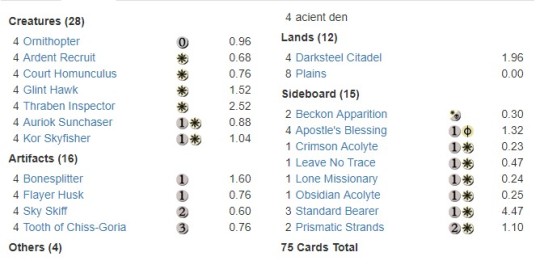
This deck looks to take advantage of Metalcraft, an ability that requires you to have at least 3 artifacts on the battlefield. For a deck like this, these vehicles become extra artifacts to get Metalcraft online. With plenty of artifacts on the battlefield, they are also less of a lightning rod for artifact removal, meaning that they are more likely to survive to be able to deal damage.
So there you go folks, Vehicles in Pauper. Right now we don’t have many options, but who knows what the future will bring. They may not be top tier, but they definitely have a place in the format and can be quite useful if the deck is built to take advantage of them. I hope to be able to take this deck into a league or two in the near future because I’d like to see if it can be tweaked or improved upon.
In the meantime hope this article has been useful for you, please don’t hesitate to get in touch with feedback or questions, either here on Tumblr or on Twitter at http://twitter.com/PauperPlanes and don’t forget to check out Desert Bus.
1 note
·
View note
Text
Post Bans: Astrolabe is gone, what next?
This past Monday the 21st October 2019 Wizards announced that Arcum’s Astrolabe is banned in Pauper.
If like me, you had built a copy of the Jeskai Snow deck you’re probably now looking at the deck and wondering what the heck you do with the other 71 cards. While there are many articles out there discussing what post-ban pauper might look like now, I’ve yet to see any look at the options for the remaining shell moving forward, so that’s what we’re going to take a look at today.
Astrolabe has been a ubiquitous card in pauper decks since the release of Modern Horizons. Driving decks to run snow lands to allow for what essentially amounted to free fixing. We saw in our last article how it was powering up Bogles by making the splash for red easier. We’ve also seen Mono Green stompy decks running it to allow them to splash for Lightning Bolt, or multiple decks without a single green source running Weather the Storm in their sideboards. Most importantly it allowed the Jeskai decks to function, allowing for a proper 3 colour deck despite a very lean mana base.
Let’s start by taking a look at a fairly typical Jeskai list from the October 13th Pauper challenge.
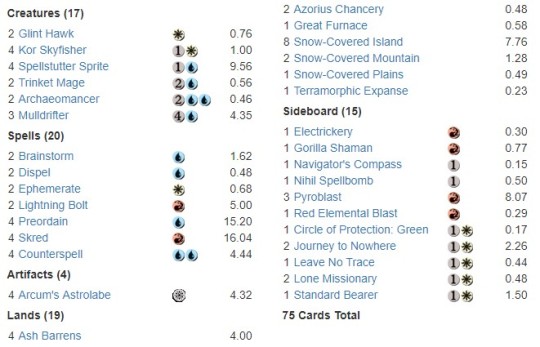
The deck is geared around generating value. In the early game, Glint Hawk and Kor Skyfisher let you replay Astrolabe to draw you cards, setting you up for the late game where Ephemerate and Archeomancer allow you to continually blink Mulldrifter to draw or your powerful removal in Skred and Lightning Bolt before beating down the opponent with an army of flyers.
The mana is heavily skewed towards snow lands or ways to tutor up a specific colour if they don’t have an Astrolabe in play. Running just an Azorius Chancery and an Izzet Boilerworks as additional fixing beyond the single copy each of the Snow-Covered Mountain and Snow-Covered Plains. Fortunately for the deck, the bulk of the spells are blue so it can operate reasonably well and dig until it hits the required fixing to activate the Ephemerate value loop.
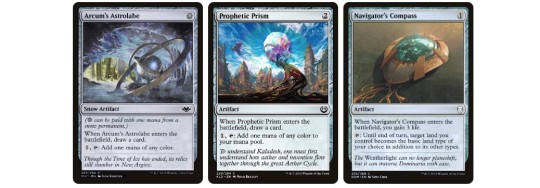
At first glance, the deck might seem to be dead without Astrolabe, but that’s not strictly true. While the mana does become much more difficult, an immediate replacement could be something like Prophetic Prism. Prism costs 2 generic mana but otherwise behaves the same as Astrolabe. It draws a card when it enters the battlefield and filters your mana. However, it slows the deck down as you can’t cast it on turn 1, but it has a similar effect and as a quick budget option to keep the deck playable it’s a possibility. Another option that has been suggested is Navigator’s Compass, which gains you three life instead of drawing a card.
To make the mana easier you could also cut back on the red splash, cutting Skred or Lightning Bolt to make you less reliant on hitting the fixing. You could even cut the deck back to just Blue-White and add some additional Journey to Nowheres or counterspells to shore up the holes left in your removal. Something like Sunlance might also be very useful creature removal.
If you cut Skred you also find yourself in the position of not needing Snow mana. While you might still choose to run snow lands for style points, it does free up some slots to experiment with a copy or two of Mystic Sanctuary which could help make up for some shortcomings of losing access to red.
However, you might also be looking at the upcoming Banned and Restricted announcement on November 18th and be wondering if Ephemerate decks continue to dominate if that might be the next card in R&D’s crosshairs. Certainly, Ephemerate has powered up Tron decks with Stonehorn Dignitary, and while the banning of Astrolabe has also slowed them down slightly, it’s a barely noticeable bump in the road for them.
In which case it might be worth looking at back some lists that haven’t really seen much play since Modern Horizons launched, for instance, Izzet Delver. This list contains a lot of the spells already in the Jeskai lists and has a very similar mana base. The namesake card is Delver of Secrets. On its front side a 1/1 for a single blue doesn’t seem like much, but in a spell-heavy deck getting it to transform to a 3/2 flyer is pretty easy. While it doesn’t fight well against Kor Skyfisher and friends, if those decks start to see less play then it becomes a powerful option again. You also get excellent card draw options in Faerie Miscreant and Ninja of the Deep Hours. So the deck does have legs even if it doesn’t quite generate the same value as the Ephemerate Archeomancer loop. However, the deck does pick up some new toys from Throne of Eldraine such as Mantle of TIdes and Mystic Sanctuary.
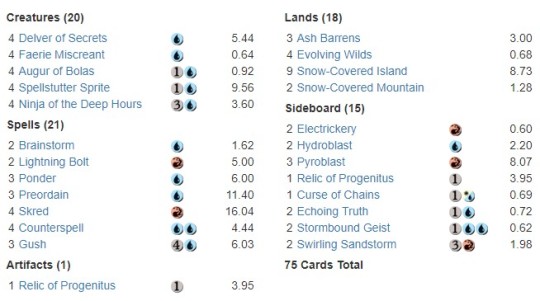
At the time of publication, the weekly Pauper Challenge is in progress so Monday will give us a good idea of promising decklists and new spicy additions that might keep the deck in the top leagues. Even if it turns out that nobody has quite found a Jeskai deck that can immediately replace this one the core blue card draw spells like Ponder, Preordain, Brainstorm and Mulldrifter will continue to have a strong presence in the format. You invested in a deck that has a powerful core of cards, so there’s no need to throw them away and start again.
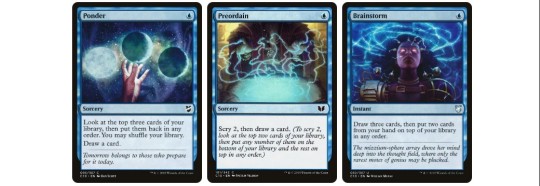
One thing is for certain, the format has been shaken up quite considerably. It’s likely that with Astrolabe out of the format there is room for exploration. There are still cards from the pauper ban list unification such as Mystic Remora that have yet to be fully explored, and likely still some toys from Modern Horizons and Throne of Eldraine that haven’t had a chance to shine yet. Mystic Sanctuary probably being the biggest of those in my opinion. The requirement for a very snow-heavy mana base hasn’t given players a chance to really utilise its full potential. Maybe invest in a playset of Deprive if you want to be truly monstrous.
I hope this article has been useful for you, please don’t hesitate to get in touch with feedback or questions, either here on Tumblr or on Twitter at http://twitter.com/PauperPlanes
1 note
·
View note
Text
Let's Look At - Bogles/Hexproof
Welcome to what I hope will be an ongoing series looking at different decks and archetypes in the format. I wanted to start strong so today we’ll be looking at a deck archetype that holds a special place in my heart and was the first deck I made in paper, Bogles.
Bogles, also known as Hexproof can be a powerful aggressive deck. The core of the deck is Green/White, but many builds splash one-off cards in other colours. The main aim of the deck is to get a single hexproof creature onto the battlefield, and then attach an increasing amount of enchantments to it, to attack for large amounts of damage. If you enjoy combat and giant creatures, this may well be the deck for you. A word of warning though, while it’s a great deck to pick up and an easy one to start with, it does come with some baggage. Some players actively dislike hexproof decks and will be very vocal in this opinion, so be careful.
If you are a player who dislikes Hexproof, scroll to the bottom of the article for a guide on how to beat Bogles.
Hexproof?
Hexproof is a keyword that is found mostly on creatures, though there are the odd exceptions. Hexproof means that the creature can’t be targeted by spells or abilities an opponent controls. This means that your hexproof creature can’t be targeted by a lot of your opponent’s removal spells.
Core Cards
Let’s take a look at the core spells of the deck
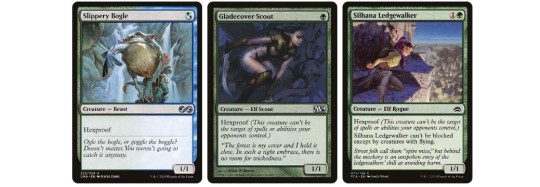
First up we have the mainstay creatures of the deck. There’s the deck’s namesake, Slippery Bogle, and Gladecover Scout at 1 mana, and Silhana Ledgewalker at 2. These are your hexproof threats, you need to get one of these on the battlefield as early as possible. In fact, these are so important, that when you play the deck you’ll often find yourself mulliganing aggressively to make sure you start the game with one in hand.
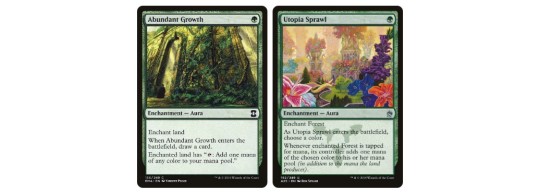
Next up are your Land enchantments, Abundant Growth and Utopia Sprawl. These are crucial for fixing your colours and drawing some colours. Utopia Sprawl also helps ramp you, which can be vital if you’re racing towards being able to play multiple spells per turn.
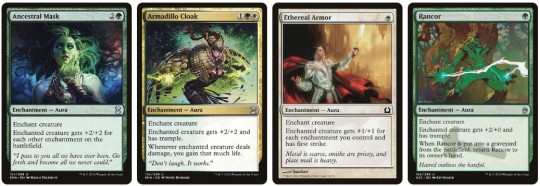
Finally, we have the core creature enchantments. Ethereal Armor and Ancestral Mask can both make your creatures extremely large very quickly. Ancestral Mask also has the benefit of counting your opponent’s enchantments too. Rancor is vital as it can be recurred if your opponent does manage to remove your creature, ensuring you have an enchantment back in hand for a new creature. It also provides trample which prevents your opponent from sticking small creatures in the way of your massive attacks. Armadillo Cloak also provides trample, but it also helps you win a race by gaining life when the creature deals damage.
An important note here, Armadillo Cloak does not give lifelink, it has a triggered ability. This means that you gain life for each Cloak on the creature.
Flex Slots
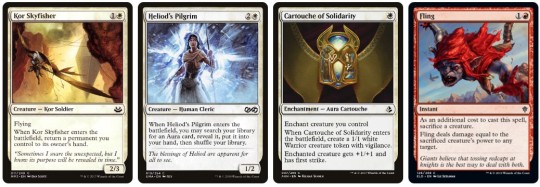
So that’s the core of the deck. But we have some flexible slots available to play about with. A couple of options that are very good in the main deck are Cartouche of Solidarity which gives you a 1/1 warrior token as sacrifice fodder for removal spells like Chainer’s Edict. Fling gives the deck a way to win against Stonehorn Dignitary decks, which look to take away all of your combat steps leaving you with a giant Bogle that does nothing. Heliod’s Pilgrim lets you search for a specific enchantment to help you in a certain situation. Kor Skyfisher has been included in builds of the deck for a while, it can pick up your land enchantments to let you draw more cards or reset your fixing, for a while it had faded out of use but has seen an increase in play recently.
The current builds of Bogles have begun to leverage the powerful artifact Arcum’s Astrolabe. Switching to a mana base of Snow Lands allows for Astrolabe to act as another Abundant Growth, drawing you cards and fixing your mana to make sure you can hit your splash colours. Astrolabe is also the main reason that many decks are running 4 Kor Skyfisher in the main again, as the Astrolabe/Skyfisher package is a powerful one.
Sample Decks
Here’s an example of a recent 5-0 Bogles deck from the Magic Online Pauper League. https://www.mtggoldfish.com/deck/2362944#paper
As you can see to make room for the Astrolabe package, they’ve had to trim down the creature numbers, dropping to just 2 Ledgewalkers. Astrolabe also provides sideboard flexibility, allowing the deck to run 4 colours. This decklist is a great example of a good sideboard for an unknown meta. With some common staples in the list. I’m not going to go too in-depth on the sideboard here as I’d like to try to write up a sideboarding guide as a bonus article.
In case you’re interested my personal paper build of Bogles can be found here: https://deckstats.net/decks/129277/1291932-bogles
Aura Gnarlid has been a favourite pet card of mine, often acting as a massive unblockable threat in the late-game. In fact, I’m so attached to the fuzzy critter that I didn’t have the heart to break up the deck to convert it to the snow version, which I’m lobbying to be referred to as “Snowgles”. That means that I’ve just finished putting together a second copy of the deck with all the Astrolabe goodness, you can find that here: https://deckstats.net/decks/129277/1406459-snowgles
How to beat Bogles?
Hello Bogle-haters, here’s the section where we look at how to beat the deck. Bogles players, it’s always useful to know how your strategy can be stopped, it helps you play smarter.
There are a few ways to stop a Bogles deck. You can bring in enchantment removal to get rid of key enchantments, Leave No Trace is a very good example of such a card. Another option is to use counterspells to try to stop them from getting a creature big enough to threaten you. There are also some specific cards that work very well to shut down the deck’s whole plan.
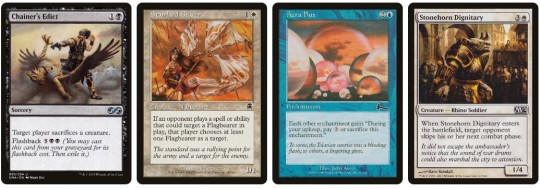
I mentioned Stonehorn Dignitary earlier, big mana decks like Tron will use their mana to flicker it multiple times preventing Bogles from ever attacking again. With the recent prevalence of this deck, they do run two copies of Fling to counter this strategy, but hopefully by the time they’ve found a Fling you’ve got counter magic in hand.
Geth’s Verdict and Chainer’s Edict don’t target a creature, so they can be used to force the Bogles player to sacrifice a creature. Often you’ll find that a Bogles player will look to spend as much mana as possible on enchantments, so you can often find a hole where they only have one creature on their side of the board opening them up a being very disappointed as they have to sacrifice it.
Standard Bearer is a fantastic anti-Bogle card for white decks. If you’ve paid attention to most of the core enchantments in the deck, you’ll notice they all say “enchant creature”. This means they can enchant your creatures as well. Standard Bearer will force those enchantments to target it, effectively preventing the Bogles player from casting any more enchantments until they find a way to remove it.
Aura Flux is not a card you want to add to your sideboard against an unknown field, but if your Local Game Store meta has a known Bogles player, this can be a very powerful way to prevent them from keeping a lot of auras on the board.
Summary
So there you have it, that’s Bogles. I’ve not gone too deep on strategies for this deck because the deck itself is fairly linear. It’s easy to pick up and play if you’re new to the format, or just enjoy smashing in with giant creatures. There are more complex lines to be found as you begin to learn the deck and the metagame around it, so it’s a deck that will grow with you. It may not be a top-tier deck right now, but it’s a tonne of fun to play and I know that I’m almost always likely going to have a build lurking in paper for when I have the urge to suit up a 1/1 and get attacking.
In the meantime I hope this has been useful for you, please don’t hesitate to get in touch with feedback or questions, either here on Tumblr or on Twitter at http://twitter.com/PauperPlanes
3 notes
·
View notes
Text
Yet Another Throne of Eldraine Review
I’m sure by now you’ve read a bunch of articles about the impact of Throne of Eldraine on pauper. Well, I’d be remiss if I didn’t add my voice to the mix. This isn’t necessarily a top X list of cards I think will break into the format, rather some cards that caught my interest that I’d like to talk about.
Let's start off by looking at the new mechanics.
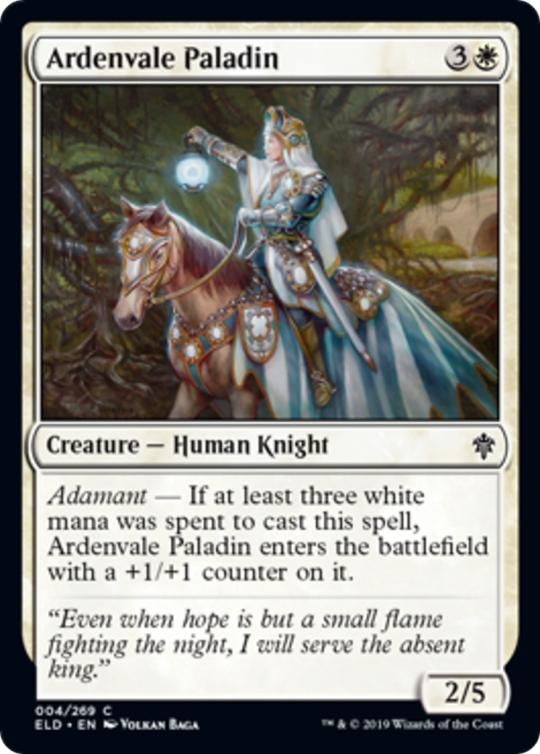
Adamant
Adamant rewards you for paying 3 mana of the same colour on a spell. By necessity, this means that all of the Adamant spells will cost at least 3 mana. Pauper isn’t short on mono-coloured decks, so it’s possible that there are some cards that provide useful effects.
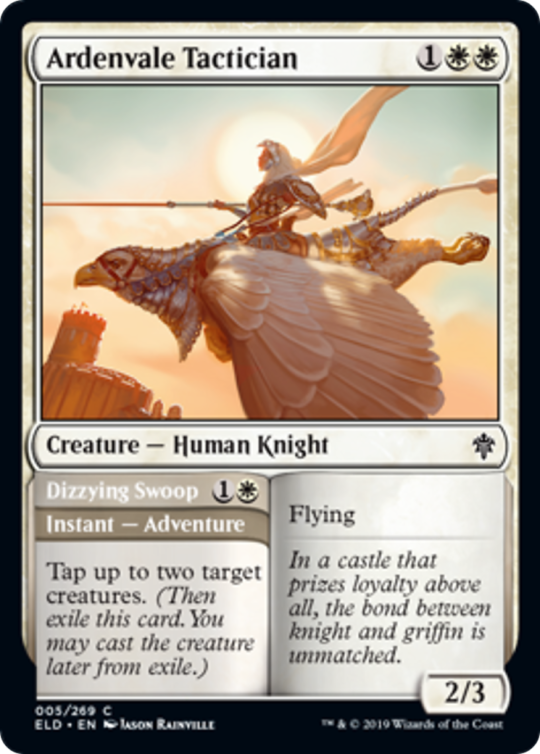
Adventure
Adventure is a mechanic that can be found on creatures. These cards will have a unique book-like text box. On one side is the normal creature text and abilities, the other side is the adventure. The adventure is either an instant or sorcery and you can cast the adventure at any time you could cast the spell. If you cast the creature’s adventure, you put the creature into exile. You can then cast the creature from exile later. Alternatively, you can just cast the creature. Most of the adventure payoffs in Throne of Eldraine are at uncommon, so we’ll just be looking at whether the combination of spell and creature make them worth it.
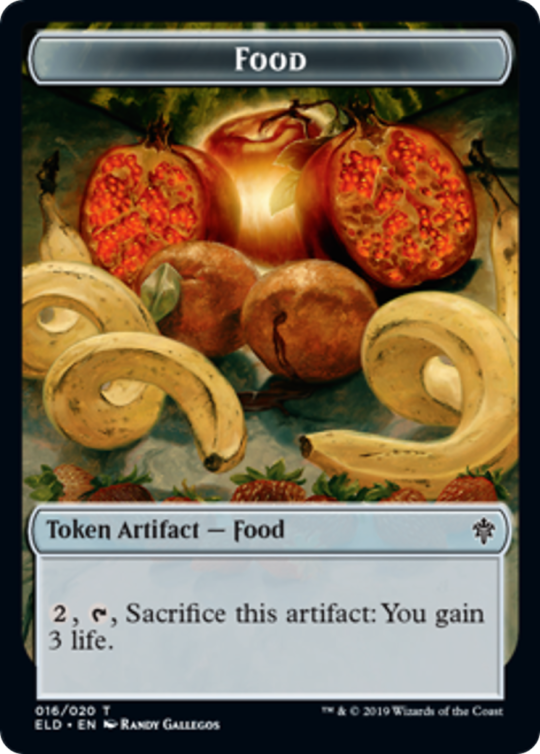
Food Tokens
The final mechanic is Food Tokens. Many cards in the set will instruct you to create a food token. Food tokens are artifacts, you can pay 2 generic mana, tap and sacrifice the food to gain 3 life. As with Adventures most of the food token payoffs are at uncommon so we’ll just be looking at the value of the food token in its own right. The immediate comparison is to Clues from Shadows Over Innistrad. A Clue Token is also an artifact, you pay 2 generic mana and sacrifice it to draw a card. Drawing a card is definitely a more powerful effect than gaining 3 life, but food tokens seem to be a little easier to create. It’s entirely possible that decks such as Mono-Block that typically lack lifegain and often spend a lot of life to draw cards would like to have a few of these lying around. However, given the current prevalence of Snow lands and Arcum’s Astrolabe, a lot of decks are simply splashing green in the sideboard for Weather The Storm. However, these end up working out, I’ve definitely got my eye on a couple of cards to experiment with and that’s half the fun.
Right. Now that’s done, onto the cards!
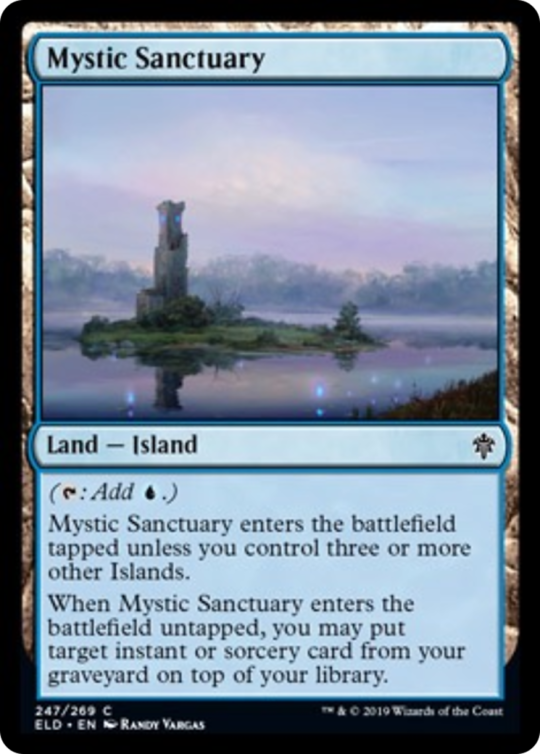
Mystic Sanctuary
Let’s start with the card that I think is the most likely to see play in the format. Mystic Sanctuary is an easy include in mono-blue decks and provides another way to recur instants and sorceries from the graveyard. The Island subtype is also very useful as it still counts for the affinity cost on Spire Golem. At the moment Mono-Blue strategies have waned since the banning of Gush, Daze and Gitaxian Probe, but this could be a useful tool for them going forward.
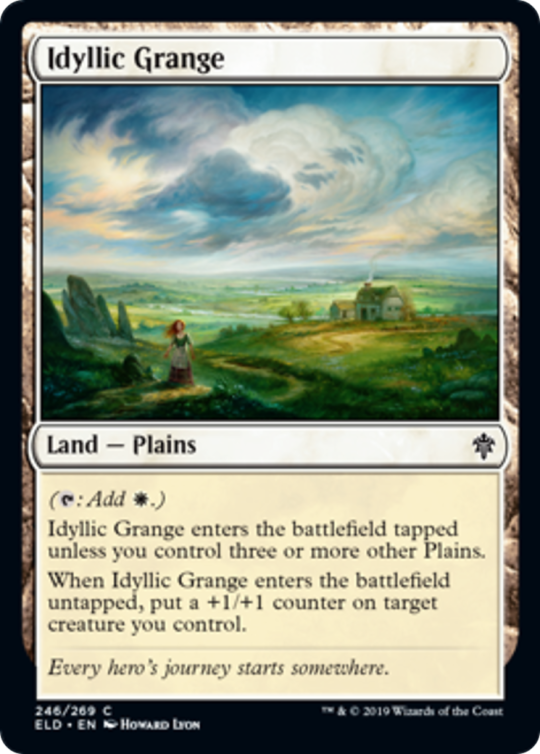
Idyllic Grange
Idyllic Grange is the other land from this cycle that I’m interested in trying out. I think this could be a useful one or two of in Mono-White Heroic. In that deck, this entering tapped on early turns is a huge downside, but late in the game that +1/+1 counter could really matter. It’s important to note that Heroic only triggers off spells and not abilities, but a free +1/+1 counter from a land drop could be worth the include.
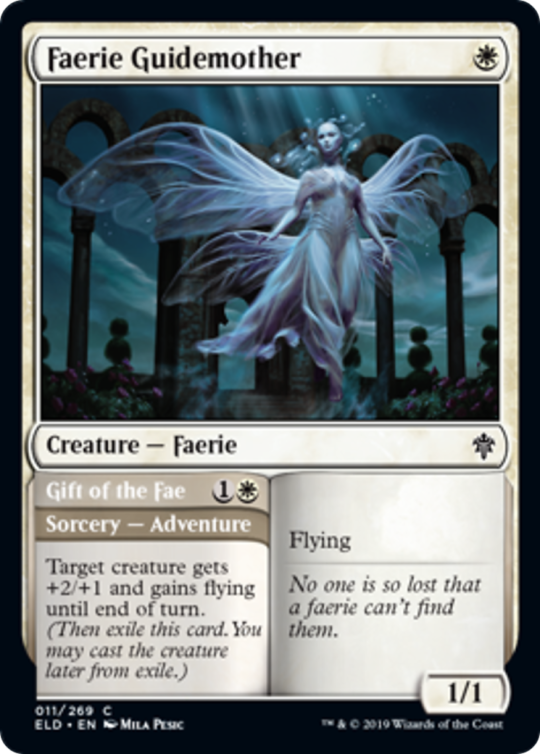
Faerie Guidemother
Faerie Guidemother is another possible include for Mono-White Heroic. The adventure is essentially a Mighty Leap, which doesn’t see play in the deck, but the possibility of being able to cast a 1/1 flyer later in the game to rebuild your board could actually sway the card into useful territory. Well worth an experiment.
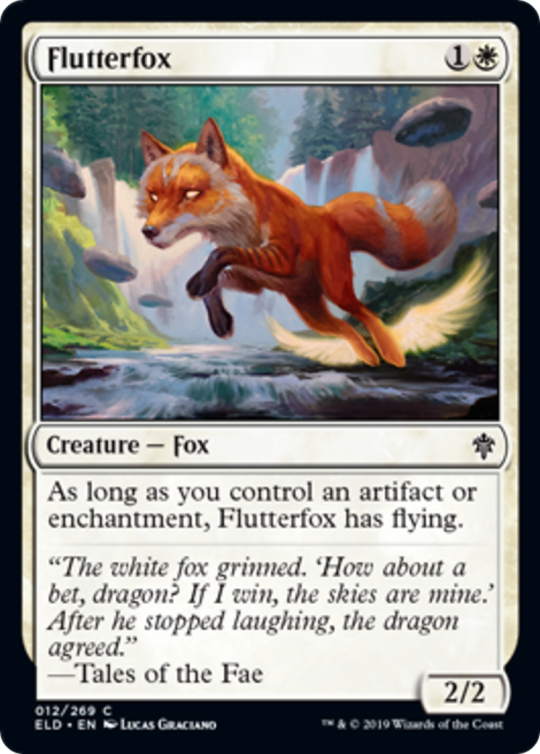
Flutterfox
When I first saw this card I immediately thought of some sort of White-based artifacts deck. Ancient Den helps cast this as well as granting it flying. But in comparison to Glint Hawk and Kor Skyfisher this ends up being on the low end of the power spectrum. It’s a curious card and if nothing else I’m excited to try to brew some sort of terrible deck around this just to see how good it might be.
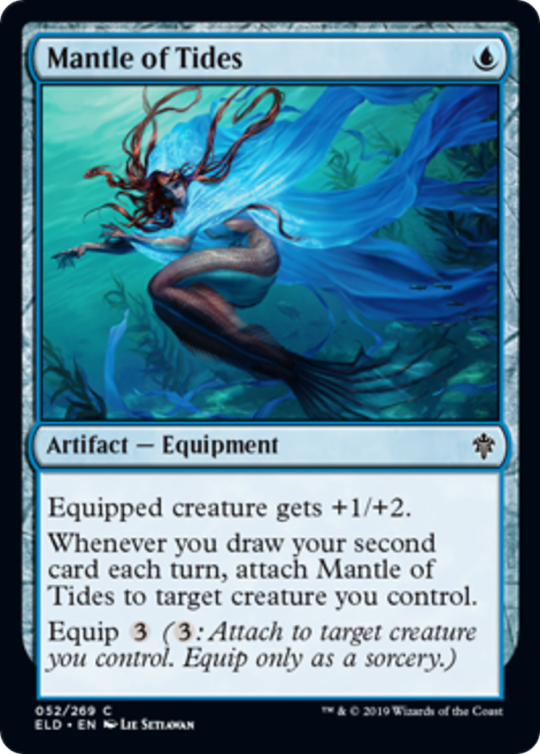
Mantle of Tides
Mantle of Tides intrigues me. Blue decks are not short on card draw, so getting the free equip should be relatively easy. Imagine on your opponent’s turn, letting them declare attackers and casting Brainstorm in response to move the Mantle onto your blocker and set up a profitable block. That being said, I don’t see exactly where it fits, but again I want to try to experiment with this
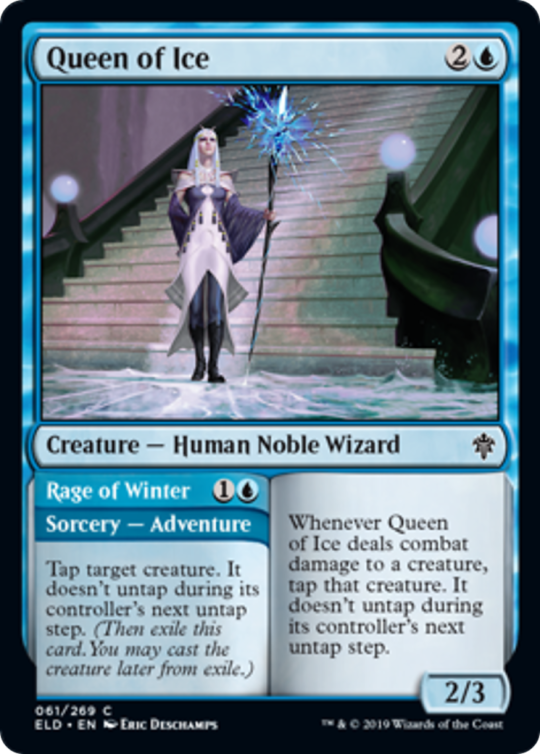
Queen of Ice
In Limited I keep being amazed that this card is common. The adventure is a good rate to lock down a creature, and the body that you get the following turn is also very useful. The ability to tap down a creature she does damage to is also pretty relevant. It makes attacks awkward for your opponent. That being said, this is a constructed format, but I still think there’s a possibility that Elsa here could be a real role player. When you finally cash her in as a chump blocker she stops that creature attacking next turn too.
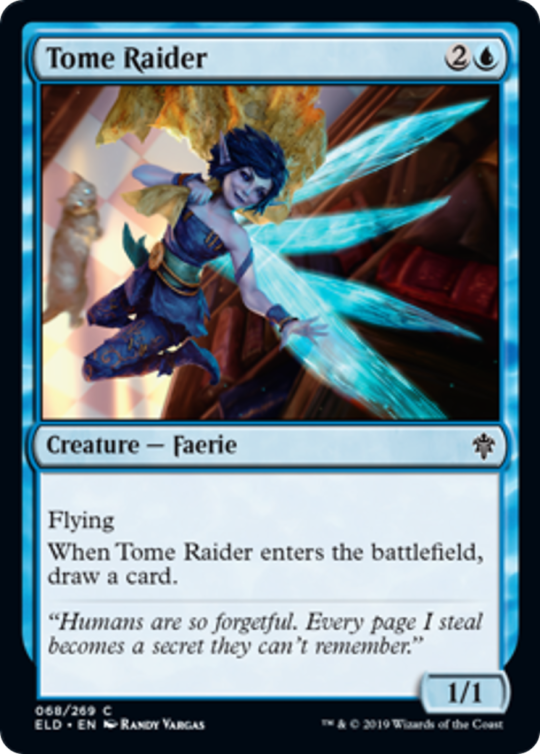
Tome Raider
As a 1/1 flyer for 3 that draws a card Tome raider is below rate, even with the faerie subtype to power up your Spellstutter Sprites. My main reason for including it in this list is just to call out the amazing card name.
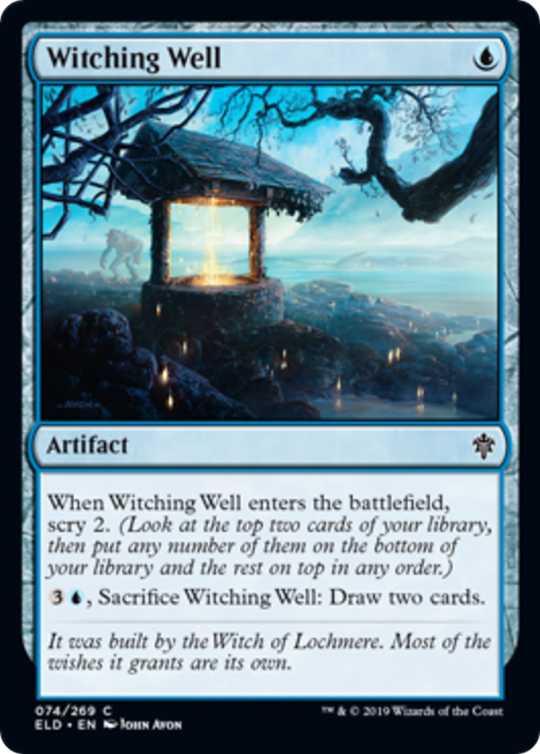
Witching Well
Witching Well is another potential blue card draw engine, it’s cheap to play and the scry 2 early in the game is very valuable. Being able to cash it in for cards later is also very powerful. Again this is another card that looks like it has real potential, but I just can’t see where it currently fits in the format.
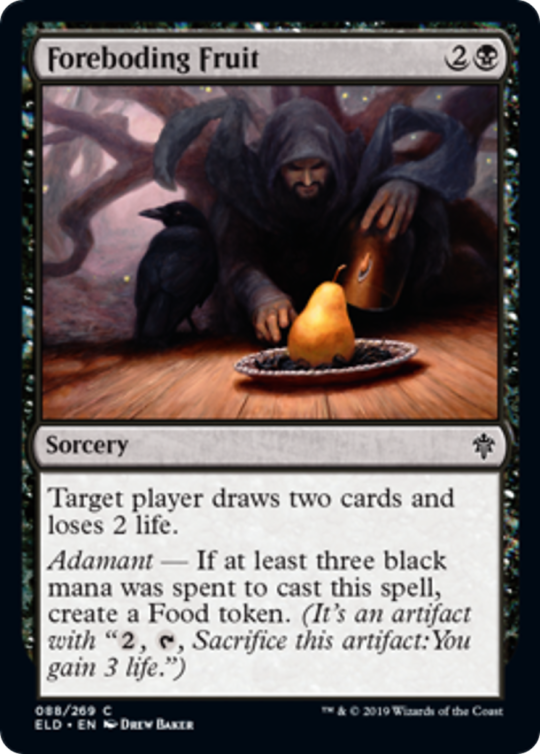
Foreboding Fruit
I love playing Mono-Black Control. It’s a fantastic deck that is filled with similar cards to this. The immediate comparison is to Sign in Blood which costs 1 mana less. However, in Mono-Black you’re always going to be triggering Adamant, so the extra mana could be worth it for the food token. It allows you to regain the life lost to the card draw at some point in the future when you have the spare mana. This is something that black decks could find really useful especially in match-ups against aggressive or burn decks where hurting yourself to draw cards just accelerates their clock.

Lost Legion
Lost Legion might not be playable in the format, but as a 2/3 for 3 this is a decent body. The ability to Scry 2 on entering the battlefield seems like a nice bonus. I’m definitely going to be keeping this in mind in the future
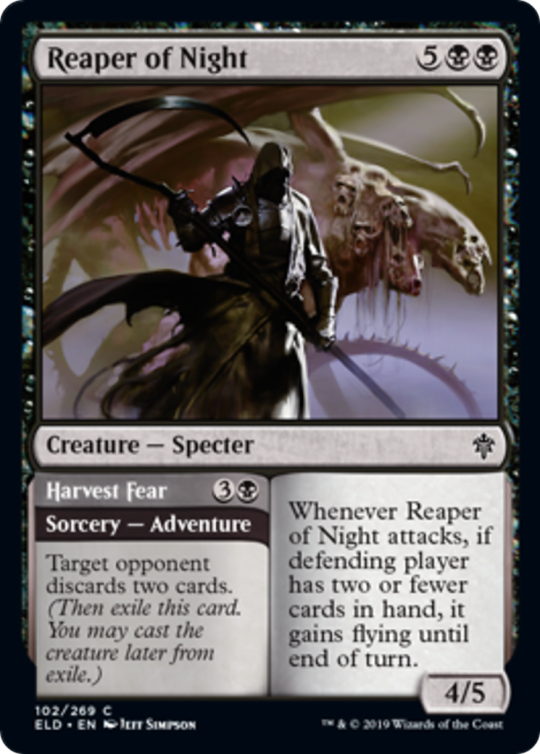
Reaper of Night
I think Reaper of Night is too over costed for its own good. On face value a 4/5 sometimes flyer seems like it might be a good finisher, but 7 mana is a lot. The adventure could be impressive, turn 4 is when your opponent starts to have fewer options for discard so making them discard 2 could give you a small edge, but with so much card draw from blue decks, it might not even matter. I wanted this to be good, but I just don’t think it’s going to get there.
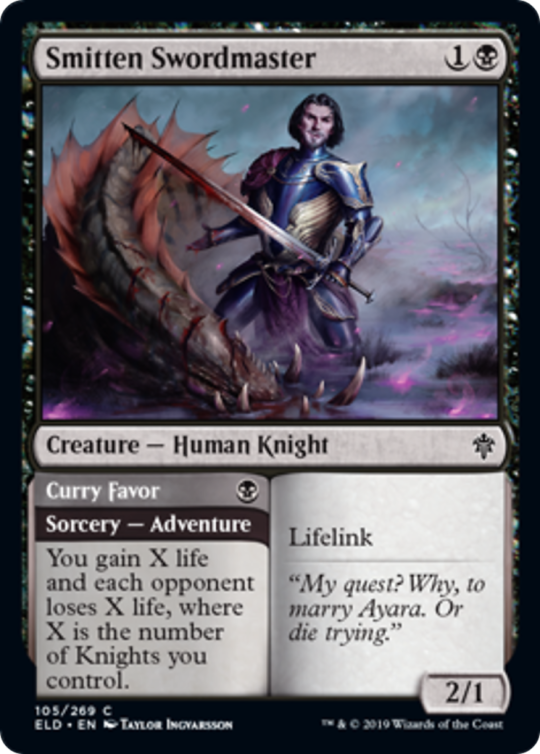
Smitten Swordmaster
This card might be what enables a new tribal deck. With the new cards from Throne of Eldraine, there are almost enough good Knights at common to enable a deck, making the adventure on Smitten Swordmaster a very good prospect, the 2/1 lifelink body also provides good value. This is probably going to be my first new brew for the set because I’m excited to see what’s possible.

Merchant of the Vale
We refer to Merchant of the Vale’s ability as rummage. It’s not as good as looting (draw then discard), but in an aggressive red deck if you’re flooding out, being able to spend some mana to ditch excess lands in your hand for new cards could be useful. It doesn’t have an obvious home, but there are decks that might be eyeing this up as a way to dig to your finishers.
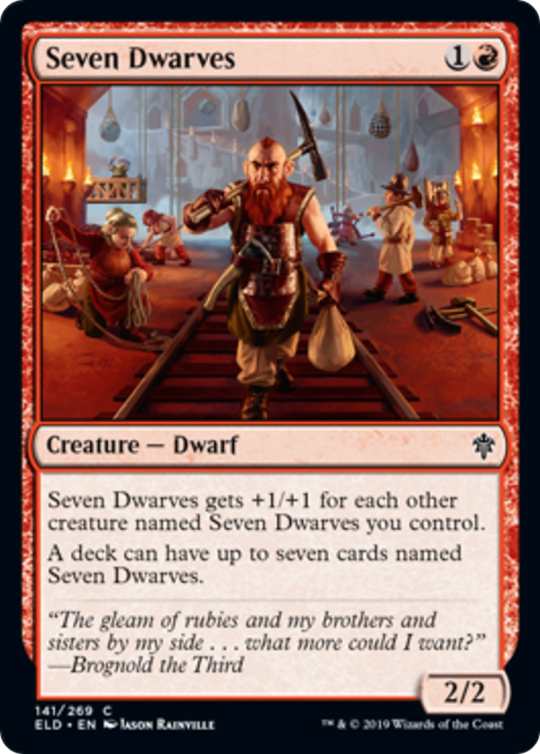
Seven Dwarves
I don’t think a Seven Dwarves deck is playable, However, it is almost certainly going to get built as a meme deck but at least a few deck builders, so keep an eye on the League results that Wizards publish in case a list ever makes it to a magical 5-0.
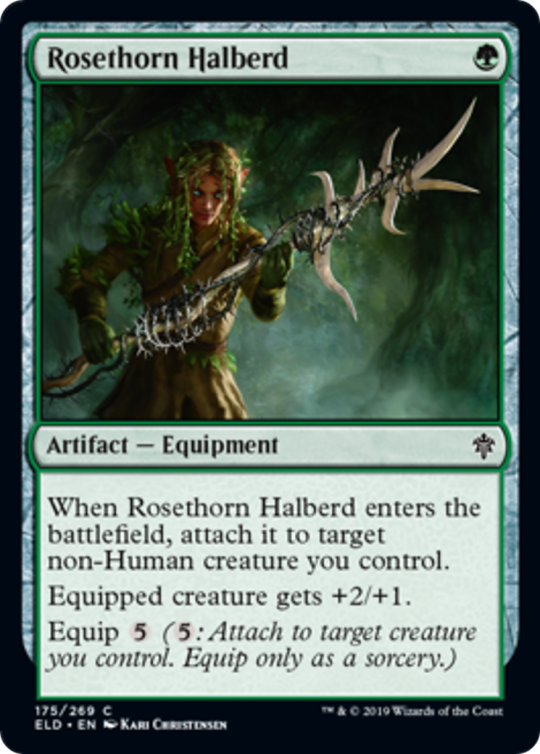
Rosethorn Halberd
Mono-Green Stompy is currently a top tier deck, and in the current configuration, it doesn’t run any humans. If this ever becomes unattached it’s unlikely that you’re going to have the spare mana to equip it to a new creature, but a 1-mana way to give a creature a permanent +2/+1 buff is something that the deck could be interested in. Sadly this buff has to happen at sorcery speed which means you can’t use it as a combat trick. I’m currently struggling to figure out if the downsides outweigh the benefits. I want to start by trying at least two in a stompy build to see how it performs.
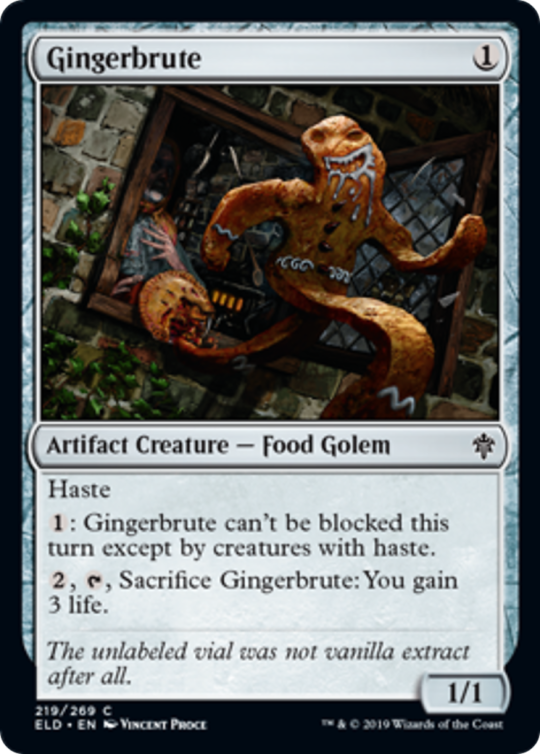
Gingerbrute
When I first saw this I fell in love with the flavour of the card. Then I started looking at how many haste creatures are in the format. I started trying to brew some sort of Voltron deck that let Gingerbrute get really big and attack freely. But then I remembered just how much artifact hate is currently running around in the format thanks to Astrolabe and my dreams of attacking with a giant Gingerbrute fell apart. Nevertheless, I wanted to mention it just for the sweet sweet flavour.
Summary
So there you have it, these are the cards from Throne of Eldraine that caught my eye. On a first pass I didn’t spot anything that jumped out as a must-play, but to be honest it tends to be supplemental products like Modern Masters or Modern Horizons that add the most cards to our format. But it’s nice to see that Wizards are continuing their new strategy of allowing commons to have a little more complexity and power than previous sets.
Something I’m hoping to do is to come back to this set in 6-months time and see what did or didn’t make it into the format.
Did I miss a card you’re excited for in the format? Did I get too excited for one of the cards on this list? Let me know either here on Tumblr or on twitter at http://twitter.com/PauperPlanes
2 notes
·
View notes
Text
The Basics - Colour Fixing Lands
So you’re looking to build a multicolour deck in pauper. You’ve got your theme, you know your colours and now it’s time to take a look at your lands. “Oh no!” you think, “this is pauper, there are no fancy untapped dual lands here, no shocks, no fetches how on earth do I build this?”. Well, let's take a look at the colour fixing options available and go over some of the pros and cons. In this first article, we’ll look at the mana fixing options available on lands, we’ll cover other forms of fixing such as artifacts in a future article.
How Many Colours?
The fact of the pauper mana base is that almost all of our fixing options give us a tapped land. We lack the ability of other eternal formats to fetch for a Volcanic Island or a Ravnica shock land. Even the Khans of Tarkir and Shards of Alara Tri-lands are uncommon and unavailable to us. That creates an interesting deckbuilding challenge. Three, Four and Five colour decks were, until recently, very difficult to build. To ensure consistent access to your colours, there are hoops you have to jump through or sacrifices you have to make to your deck to give up non-land slots to mana fixing. Decks like Tron or Affinity have large amounts of mana and artifacts that can filter that mana to the colours they need. Bogles sometimes relies on Utopia Sprawl or Abundant Growth to turn their forests into rainbow lands. But let’s assume that you’re not looking to go in that direction, then your best bet is either a mono-colour or two colour deck. If some of those deck names seem like gobbledegook, don’t worry we’ll be taking a look at them in future articles.
#1 The M19 Tapped Duals

Here we are. This is the bog standard default mana fixing for pauper. A non-basic land without a land type (Island, Mountain etc) that enters the battlefield tapped. These lands were first printed at uncommon in Oath of the Gatewatch and Shadows over Innistrad, entering our format in dribs and drabs as they got reprinted at common in Planeswalker decks. Core Set 2019 finally gave us the full cycle at common with one included in every pack. This makes these duals easily available. If you look at most of the top tier decklists you’ll see that almost nobody plays them, this is because there are better options available to us. We’ll take a look at those other options later, but it’s worth bearing these in mind if you have an abundance of them from drafting M19. The other place that these are really useful is in Standard Pauper on MTG Arena. It looks as though Wizards are going to keep these in standard in some form going forward, so if you’re looking to play on Arena, these are a good option.
#2 The Ravnica Guildgates
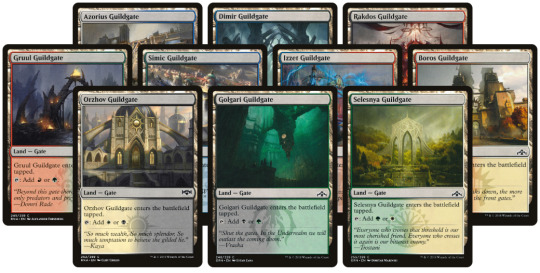
If you’ve been playing more recently during Guilds of Ravnica or Ravnica Allegiance then every pack has a guildgate instead of a basic land. These aren’t much different from the M19 duals above, but they have one important characteristic, the gate subtype. There are a few common cards that care about gates, for instance, the recently printed “Open The Gates” lets you search up a basic land or a gate. This could be a powerful way to fix your mana in base green decks. In Standard Pauper these are dual lands 5-8 right now, so if you’re looking to build a multicolour deck bear these in mind.
#3 The Khans Gainlands

Here we go. These are the gold standard of dual lands in pauper. Khans of Tarkir gave us this cycle of common tapped duals designed to make the intensely multicolour draft format based around 3-colour tribes work. As they’re common they still enter tapped, but as well as fixing your mana they gain you a life. It’s often said that pauper games start with both players at 21 life because these are such a great turn 1 play. With the recent reprinting in M20 these should be easy to get a hold of at the moment, but if you don’t have access to these then our previous cycles are perfectly workable, but the extra few life points can be valuable against aggressive decks.
#4 The Karoo Lands

Our final cycle is known as the Karoo Lands. This cycle comes from the original Ravnica block. When these lands enter the battlefield they require you to return another land to your hand. This ability first appeared on the card “Karoo” which was first printed way back in Visions, hence the name for this cycle. These lands are often included in small numbers in two colour decks with a very even split. They differ from the other cycles that we looked at above because they tap for two mana, making them especially potent in decks with ways to untap lands. However, these are a bad turn one play because the ability is not optional, and the only land available to return is the one you just played. Often you’ll see these played on turn 2 returning a Khans land to hand, which is then replayed on turn 3 to gain you another life. Don’t forget that you can always tap the land you’re planning to bounce for mana first so you don’t get too disrupted and the fact that they tap for two keeps you at parity on tempo. These lands are also a fantastic late-game play as they let you bounce utility lands to your hand to regain their effect. We’ll take a look at some of the utility lands on offer in a future article.
#5 “Fetches”
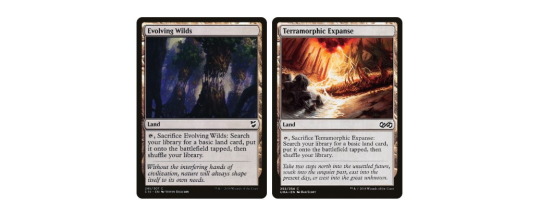
Evolving Wilds and Terramorphic Expanse. These are Pauper’s Fetchlands, printed in many sets as a way to provide fixing for limited gameplay, though these days you see Evolving Wilds in sets instead of Terramorphic Expanse. Functionally both cards are the same. They enter the battlefield untapped but don’t tap for mana themselves. You can then tap and sacrifice them to search for a basic land in your deck, which enters the battlefield tapped. The downside to fixing your colours is that you lose a turn while the land enters tapped. A common gameplay technique with these is to tap and search in your opponent’s end step so they don’t know which colour you’re looking for. These are particularly good in decks with a small number of lands in their second colour. You can’t always rely on naturally drawing a dual land or a basic of the right colour, so these provide additional ways to get those lands for critical turns.

Until the printing of Arcum’s Astrolabe, Ash Barrens was the new hotness in pauper. Initially only printed in a commander product availability was an issue, but we saw a reprint in Masters 25 and Commander 2019 bringing the price down to a slightly more affordable level. Ash Barrens is often used in the same sorts of decks as Evolving Wilds. The cycling is powerful because it can be done at instant speed, so in a blue deck you can leave mana up for a counterspell and then cycle at the end of your opponent's turn if you didn’t need it. Blue decks also enjoy this as a way to reliably shuffle your deck after a brainstorm. In a pinch, it can even be played untapped as a colourless land. This flexibility makes Ash Barrens more powerful than Evolving Wilds, though it’s still not really any faster than evolving wilds as the cycling ability costs mana to activate.

The Panoramas from Shards of Alara are an interesting set of lands. Like Ash Barrens they tap for colourless mana in play, but can fix you at the cost of a mana and sacrificing the Panorama. Like Evolving wilds the land you fetch comes into play tapped. This generally makes them slower than Evolving Wilds or Ash Barrens and as such they don’t see play in any decks.
#6 Others
Let's take a look at a few other common fixing lands that don’t fit into a particular cycle.

Crumbling Vestige doesn’t see much play but is sometimes used in builds like 5-colour Bogles, where they need a single coloured mana for just one key spell. While you can pick it up again with Karoos or other effects, it’s not really worth running unless you absolutely need it.
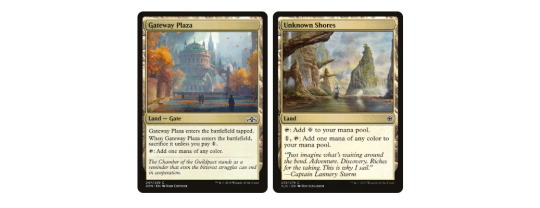
Gateway Plaza and Unknown Shores are examples of this type of fixing. Wizards likes to usually have an effect like this in standard as it can help draft or sealed. There are plenty of similar cards, but none of them are really played in Pauper, as there are also plenty of fixing artifacts that filter your mana and have other upsides, but we’ll talk about those in a future article. However, these are often considerations in Standard Pauper. While they may look great at first glance, they have downsides. Gateway Plaza will cost you a turn as you have to pay one mana when it comes in but does fix your mana nicely from there on. Unknown Shores only filters mana for fixing, so if you need a specific colour the spell effectively costs 1 more. However, if you happen to have a few cards like this in your collection and don’t want to spend your wildcards on the other lands we’ve talked about then they’ll get the job done, but it’s worth remembering that there are better options available.
Summary
So there you have it. These are the current options for mana fixing via lands. From the Khans Gainlands to Ash Barrens and everything in between. However this isn’t the full picture and many decks will often rely on artifacts for their fixing instead, so we’ll pick that up in a future article. In the meantime I hope this has been useful for you, please don’t hesitate to get in touch with feedback here or on twitter at http://twitter.com/PauperPlanes
3 notes
·
View notes